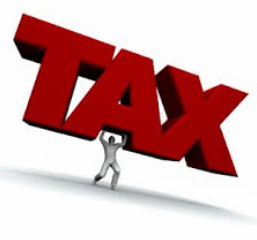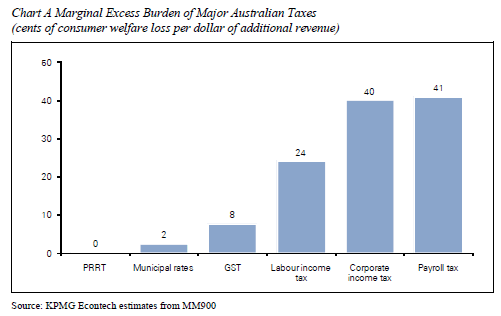
The Australian’s David Uren has produced some good analysis today of the growing tax burden likely to fall on lower-income Australians as bracket creep, brought about through inflation, pushes them into higher tax brackets and raises their average tax rate:
ALLOWING inflation to push more personal income into higher tax brackets will punish low-income earners the hardest, increasing their tax rates by as much as 25 per cent over the next four years, while leaving those at the top of the income scales virtually untouched.
While the government struggles to get savings measures through the Senate because of their perceived unfairness, the increase in personal income tax resulting from “bracket creep” will raise more than $20 billion a year by 2017-18, or more than all the government’s proposed savings measures combined…
…analysis by Deloitte Access Economics shows that keeping the income tax scales fixed, rather than adjusting them for inflation, will be highly regressive. Someone earning between $35,000 and $40,000 will be paying 25 per cent more tax by 2017-18, with the average tax paid on their income rising from 13 per cent to 16.3 per cent.
High-income earners with salaries of $200,000 or more will face only a 1.8 per cent lift in their tax, with the average rate rising from 38.0 per cent to 38.7 per cent…
In all the opposition to re-indexing fuel excise and raising the GST on perceived fairness grounds (despite their greater tax efficiency), commentators often lose sight of the fact that bracket creep is arguably even more regressive and punishes lower income earners more.
Ross Gittins, who is typically fair-minded, has previously made similar protestations about the adverse impacts of bracket creep on lower income earners:
The average full-time wage next financial year, 2014-15, will be about $76,000. On the basis of reasonable assumptions about the growth in wages over the three years to 2017-18, you can calculate that someone on half the average wage would see the proportion of their wage that they lose in tax increase by 3.5 cents in the dollar.
For someone on the average wage the increase would be 2 cents in the dollar. On twice the average wage it’s 1.1 cents. And on six times the average wage it’s 0.8 cents.
Now that’s regressive.
Clearly, comprehensive tax reform is required to broaden the tax base and share the tax burden, as well as to improve productivity. As highlighted many times before, the Henry Tax Review found personal income tax (along with company taxes) to be highly inefficient, producing a “marginal excess burden” (i.e. the loss in consumer welfare relative to the net gain in government revenue) higher than most other forms of taxation (see next chart).

By comparison, raising or broadening the GST in exchange for cuts to personal income taxes (or giving back bracket creep) would result in clear efficiency gains, with tax expert, Professor John Freebairn, claiming that “changing the tax mix from (income taxes to indirect taxes) brings gains of 20c to 30c in the dollar and beats anything that a major corporation could do on productivity”.
There are also compelling reasons to shift the tax system towards resource rents and broad-based land taxes on Budget sustainability grounds, to reduce the tax burden on the shrinking working-aged population, and to improve efficiency, productivity, and equity.
As shown in the above chart, the Petroleum Resource Rent Tax (PRRT) is the most efficient tax around, with zero marginal excess burden, since it applies to a tax base that is completely immobile – land. Resource rent taxes are also more equitable than either consumption taxes or income taxes.
While not shown in the above chart, land taxes have similar tax efficiency and equity to the PRRT and municipal rates, since they are also levied on immobile land. Land taxes also offer the added benefit of effectively boosting land supply and helping to make infrastructure investment self-financing for governments.
Another reform option that should be pursued with vigour by our federal leaders is to crack-down on Australia’s world-beating and poorly targeted tax expenditures – including superannuation concessions, the capital gains tax discount, and negative gearing – which are starving the Budget of crucial revenue and are broadly inequitable. As noted by Peter Martin today:
Superannuation is Australia’s biggest tax expenditure; the tax breaks given to contribution and to the earnings on those contributions when they are in the funds amount to $36 billion a year on Treasury estimates.
Parts of the superannuation industry dispute that total. But however many tens of billions it is, it is climbing as more Australians get pushed into the tax brackets where it makes sense to make use of super’s low 15 per cent tax rate to avoid income tax.
Closing just the first of the two super loopholes and taxing contributions to super at the employee’s marginal tax rate would save $17.8 billion this financial year and $20.7 billion by 2016-17…
The 50 per cent discount on capital gains tax is worth another $5.4 billion, climbing to $7.6 billion by 2016-17.
As I keep arguing, the Government needs to begin a serious discussion on tax reform that includes: 1) taxes on land/resources alongside raising/broadening the GST, in place of less efficient and/or inequitable sources; and 2) closing costly and inequitable tax loopholes.
Because simply relying on never-ending increases in personal income tax via bracket creep, while the base of workers shrinks as the population ages and the proportion of retirees rises, is neither efficient, equitable or sustainable in the longer-term.

